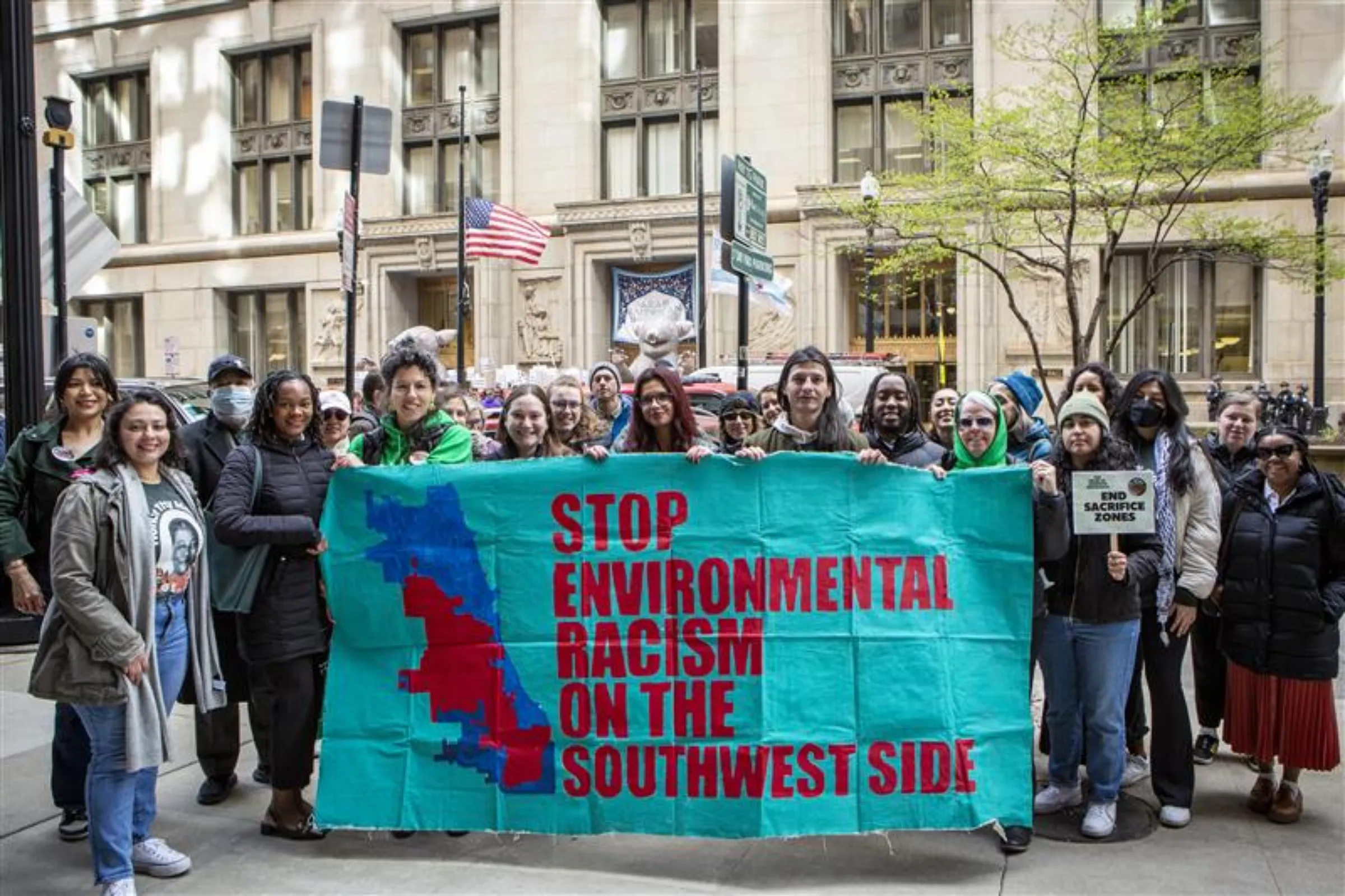Polluted and poor: Blighted US cities tackle ‘toxic soup’

Demonstrators attend a rally in Chicago, U.S., April 2025. IEC/Handout via Thomson Reuters Foundation
What’s the context?
As federal help fades, US states use their own laws to fight cumulative impact of pollution on poor and minority areas.
- Laws open new route to clean up chokepoints
- Focus on poor, ‘overburdened’ neighbourhoods
- Minnesota, New Jersey, New York at vanguard
WASHINGTON - The path to Minnesota's groundbreaking, new anti-pollution law began at a metal-shredding facility in Minneapolis before spreading its "toxic soup" along the banks of the Mississippi.
The factory, now shut, was once recognised as a source of lead, chromium and other pollution by state regulators - as well as by concerned locals such as Roxxanne O'Brien.
But as O'Brien focused on fallout from the metals factory on her impoverished north Minneapolis neighbourhood, her gaze widened to the many other industrial operations lining the river, each spewing out its own cocktail of pollutants.
"All of these different industries combined were creating a toxic soup," O'Brien, a mother of three, told Context.
She refers to these combined pollution levels as "cumulative impacts" – when multiple sources of pollution come together and hurt human health.
It is a particular concern in poor, minority areas, she said, citing places such as north Minneapolis, where heavy industry, manufacturing and transport tend to concentrate.
Regulators, meanwhile, have focused on individual operations rather than look at the implications of a concentration of industry in any given area.
But O'Brien, co-founder of a group called Community Members for Environmental Justice, is now hoping she has a solution.
The Frontline Communities Protection Act is a state law that creates a new permitting process for industry in impoverished, minority "environmental justice" communities.
The law passed in 2023, and an implementation framework is due by next May.
It’s the country’s third, after New Jersey and New York.
The trend offers a major new tool to address pollution in "overburdened" communities that backers say local officials are increasingly taking up.
This comes as President Donald Trump undermines national momentum on the issue through funding cuts and by banning government "diversity, equity and inclusion" efforts that could have helped impacted communities stave off pollution.
The Environmental Protection Agency, which in November released an interim framework for a national policy, has now "paused" that work, a spokesperson told Context.
The Minnesota bill met with pushback from industry groups, including local chambers of commerce and utilities, warning it could stifle economic development or duplicate existing rules.
Yet the need for change is a "no-brainer", said Minnesota state Representative Fue Lee, who spearheaded the law.
"If we have the tools already, why are community members still coming to me to have the state step in?"
New Jersey vanguard
Discussion of the cumulative effects of air, water and soil pollution took root in the 1980s and 1990s as communities grew frustrated with regulators' reliance on risk analysis that didn’t reflect the harm they'd witnessed first hand.
More racially segregated areas are up to 75% more likely to have high copper, chromium, lead and other particulate concentrations, with low-income communities suffering higher levels of asthma, diabetes and hypertension, according to the National Caucus of Environmental Legislators.
A facility permit might allow a set level of pollutants but did so without taking into account what other industries were polluting the area, said Ana Baptista, director of the Tishman Environment and Design Center at the New School in New York.
"So communities would be hitting brick walls every time they tried to fight these facilities," Baptista said.
She helped get the first such law enacted in New Jersey.
The new law requires regulators to consider the cumulative effects of polluting industries, strengthens their power to win changes and ensure that local voices are part of the process.
While it is too early to gauge the impact, New Jersey regulators in May issued their first decision under the law, on permits for a recycling plant, and ordered changes.
Campaigners applauded that milestone but said "significantly more could have been done to ensure protections for the surrounding overburdened communities," according to the New Jersey Environmental Justice Alliance, a coalition of groups.
In addition to Minnesota and New York, dozens of states and cities - including Maryland, D.C. and Colorado - have proposed similar laws, according to tracking by the Tishman Center.
The return of Trump has prompted many communities to turn to state legislators for their help, said Baptista, since they no longer feel the federal government will protect them.
Local voices
In 2019, researchers found that Chicago had a life expectancy gap between racially segregated neighborhoods of 30 years – the country’s widest such discrepancy.
Clustering industries in certain areas had measurable fallout: high levels of cancer, asthma and other respiratory illnesses, said Iyana Simba of the Illinois Environmental Council, an advocacy group that represents 130 groups.
"It's not just one single factory or warehouse. It's these communities that have several in the same area," she said.
The mayor and others introduced a cumulative impacts bill in April, for an ordinance that could be voted on in coming weeks.
In Minnesota, negotiations are continuing on how to implement the new law ahead of next May's deadline, with particular focus on the inclusion of "community benefits".
That could mean mitigating pollution, paying for the health problems it caused, ringfencing jobs for locals or even helping with housing, said Sasha Lewis-Norelle, an organiser with COPAL, an advocacy group that works with Minnesota’s Latino community.
"It has felt really important to work on these local laws and regulations as we're seeing so many rules from the federal level be taken away," he said.
(Reporting by Carey L. Biron; Editing by Lyndsay Griffiths and Anastasia Moloney)
Context is powered by the Thomson Reuters Foundation Newsroom.
Our Standards: Thomson Reuters Trust Principles

















